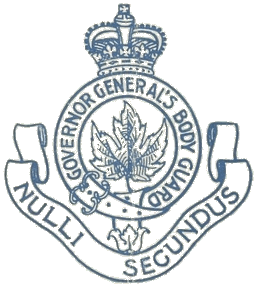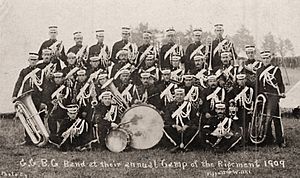Governor General's Body Guard facts for kids
Quick facts for kids Governor General's Body Guard |
|
|---|---|
 |
|
| Active | 1822–1936 |
| Country | |
| Branch | Canadian Militia |
| Type | Horse Guards |
| Role | Cavalry |
| Size | Independent Cavalry Troop (1822-1876) Independent Cavalry Squadron (1876-1889) One Regiment (1889-1936) |
| Part of | Non-Permanent Active Militia |
| Garrison/HQ | Toronto Armories |
| Motto(s) | Latin: Nulli secundus ("second to none") |
| Engagements | Upper Canada Rebellion Fenian Raids North-West Rebellion Second Boer War First World War |
| Battle honours | See #Battle Honours |
The Governor General's Body Guard was a special royal guard regiment in the Canadian Army. It was like the top cavalry units in the British Army. This group was the most important regiment in the Canadian Army.
In 1936, the regiment joined with another group called The Mississauga Horse. Together, they became The Governor General's Horse Guards.
Contents
A Look Back: The History of the Body Guard
How the Regiment Started
The Governor General's Body Guard began a long time ago in 1810. It was first known as Button's Troop. Later, in 1822, it became the York Dragoons. This was in York, Upper Canada, which is now Toronto.
In 1837, the unit was renamed the Queen's Light Dragoons. This was for their duty during a rebellion that year. By 1839, it became a separate military unit.
Over the years, its name changed several times. It was called the 1st Toronto Troop of The Volunteer Militia Cavalry of the County of York in 1855. Then, in 1866, it became The Governor General's Body Guard for Upper Canada.
After Canada became a country in 1867, it was renamed The Governor General's Body Guard for Ontario. The unit grew bigger over time. In 1876, it became a squadron with two troops. By 1889, it was a full regiment.
Finally, in 1895, it was named The Governor General's Body Guard. This name stayed until 1936. That year, it joined with The Mississauga Horse to form The Governor General's Horse Guards.
Early Adventures
The regiment's roots go back to the early 1800s in Toronto. It was the main cavalry unit for the city. It started as the York Dragoons under Captain George Taylor Denison I.
Back then, a law from 1793 said that all healthy men had to serve in the militia. The Dragoons were volunteers. They were often funded by rich families, like the Denison family. This unit was a mounted infantry group. It helped the main infantry battalion by sending messages, scouting, and protecting the sides of the group.
Full cavalry regiments were too costly to run. So, smaller cavalry troops were enough for the needs of the time. This unit was made of volunteers. They helped the British Army units in Upper Canada. In 1839, this troop became an independent cavalry unit.

In 1837, there was a threat of unrest and rebellion. The troop was one of only two uniformed militia units to respond. They got new uniforms and weapons. They were renamed the "Queens Light Dragoons" (QLD). The QLD worked with another troop, forming a squadron. They took part in several actions during the rebellion. The Toronto troop was on active duty for many months during this time.
In 1866, the troop was the only cavalry unit in Upper Canada called to active duty. They fought against an invasion from the United States by the Fenian Irish Republican Army. The troop led a column of soldiers to meet the Fenian force. They were the first unit to enter and help the town of Fort Erie. They captured some Fenians before they escaped. The Fenian force was defeated.
By the mid-1800s, Britain started to pull its army out of Canada. This made it clear that Canada needed its own army. A new law in 1855 created the Canadian Militia Department. This department officially recognized local militia units. They became a very important part of Canada's defense.
The unit was officially recognized in 1847. It was known as the 1st Toronto Independent Troop of Cavalry. It was renamed again in 1855. Then, in 1866, it became 1st York Troop The Governor General's Body Guard for Upper Canada. In 1867, it was The Governor General's Body Guard for Ontario.
After British forces left Canada completely in 1870, the Canadian government started to reorganize the militia cavalry. Most independent troops joined together into larger regiments. The GGBG was the only unit that kept its special name. It grew to squadron size in 1876. In 1889, the GGBG became a full regiment. It joined with the Markham and Oak Ridges Troops. The name changed one last time in 1895 to The Governor General's Body Guard of Canada.
The North-West Rebellion
In 1885, the GGBG was called into action as a full squadron. They helped protect the back lines for General Middleton's forces during the North-West Rebellion. Their job was to guard the main supply route. They patrolled from the railway line to Batoche. They also protected the only supply depot and telegraph station at Humboldt. A fort was built around the telegraph station and named "Fort Denison." General Middleton's force defeated the Metis at Batoche.
The South African War
In 1900, the GGBG sent about 50 men to help the small Canadian Regular Army in South Africa. Lieutenant Hampden Zane Churchill Cockburn earned the Victoria Cross. This is a very brave award. He received it while serving with the Royal Canadian Dragoons during this war.
The First World War
During the First World War, the GGBG was not sent to fight as a whole unit. Instead, it helped create new battalions for the Canadian Expeditionary Force. They also helped recruit many soldiers to join the war effort. Thousands of people from Toronto joined the army through the GGBG. The GGBG provided soldiers for many different battalions.
Joining Forces
In 1936, the regiment joined with The Mississauga Horse. This new combined unit was named The Governor General's Horse Guards.
How the Regiment Was Organized
The Governor General's Body Guard for Ontario (May 17, 1889)
- A Troop (York, Ontario)
- B Troop (York, Ontario)
- C Troop (Oak Ridges, Ontario) (This troop used to be No. 2 Troop of the 2nd Regiment of Cavalry)
- D Troop (Markham, Ontario) (This troop used to be No. 3 Troop of the 2nd Regiment of Cavalry)
The Governor General's Body Guard (March 1, 1921)
- Regimental Headquarters (Toronto, Ontario)
- A Squadron (Toronto, Ontario)
- B Squadron (Toronto, Ontario)
- C Squadron (Toronto, Ontario)
Battle Honours
Battle Honours are special awards given to military units. They show that the unit fought bravely in important battles. The Governor General's Body Guard earned many of these honours.
North-West Rebellion
The South African War
The Great War
- Mount Sorrel
- Somme, 1916
- Flers-Courcelette
- Ancre Heights
- Arras, 1917, '18
- Vimy, 1917
- Ypres, 1917
- Hill 70
- Passchendaele
- Amiens
- Scarpe, 1918
- Hindenburg Line
- Canal du Nord
- Cambrai, 1918
- Valenciennes
- Sambre
- France and Flanders, 1915–18
Famous Members
- Major Hampden Zane Churchill Cockburn: He won the Victoria Cross during the Second Boer War.
- Lieutenant Colonel George Taylor Denison III: He led the regiment during the Fenian raids and the North-West Rebellion.
- Lieutenant Colonel Frederick Charles Denison: He commanded the Canadian Voyageurs on the 1884 Nile Expedition.
- Lieutenant Colonel William Hamilton Merritt III: He served in the North-West Rebellion and the Boer War.
- Brigadier General James H. Elmsley
- Colonel John Everett Lyle Streight
See Also
- List of regiments of cavalry of the Canadian Militia (1900–1920)

